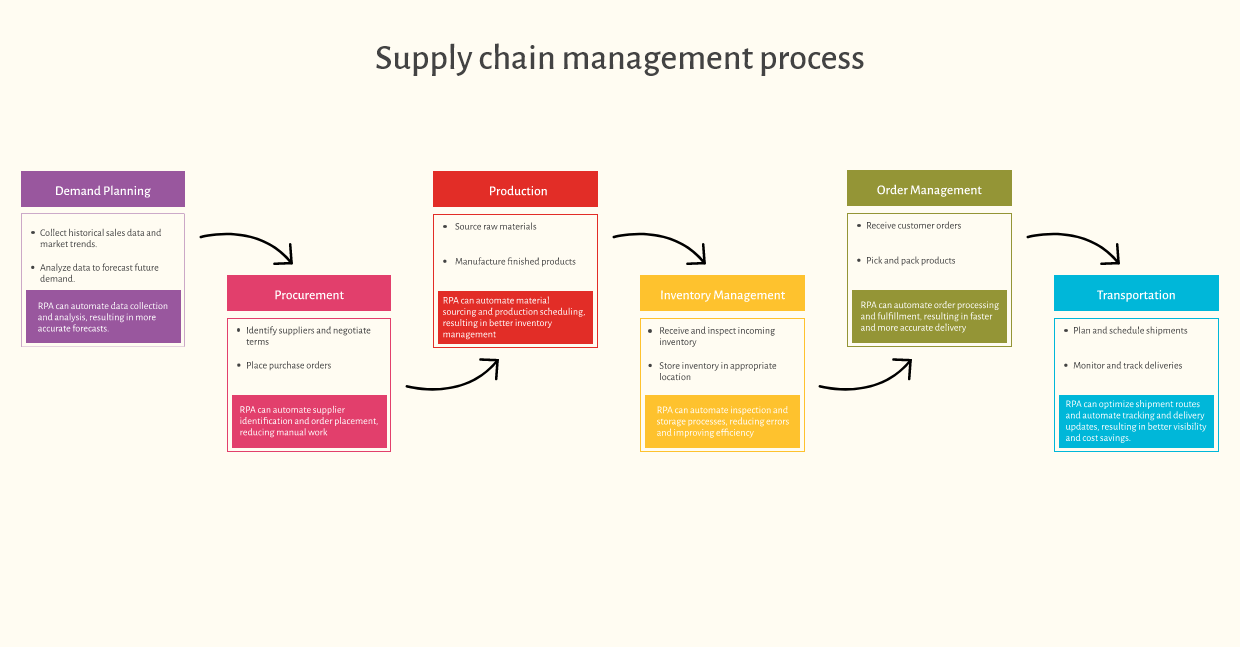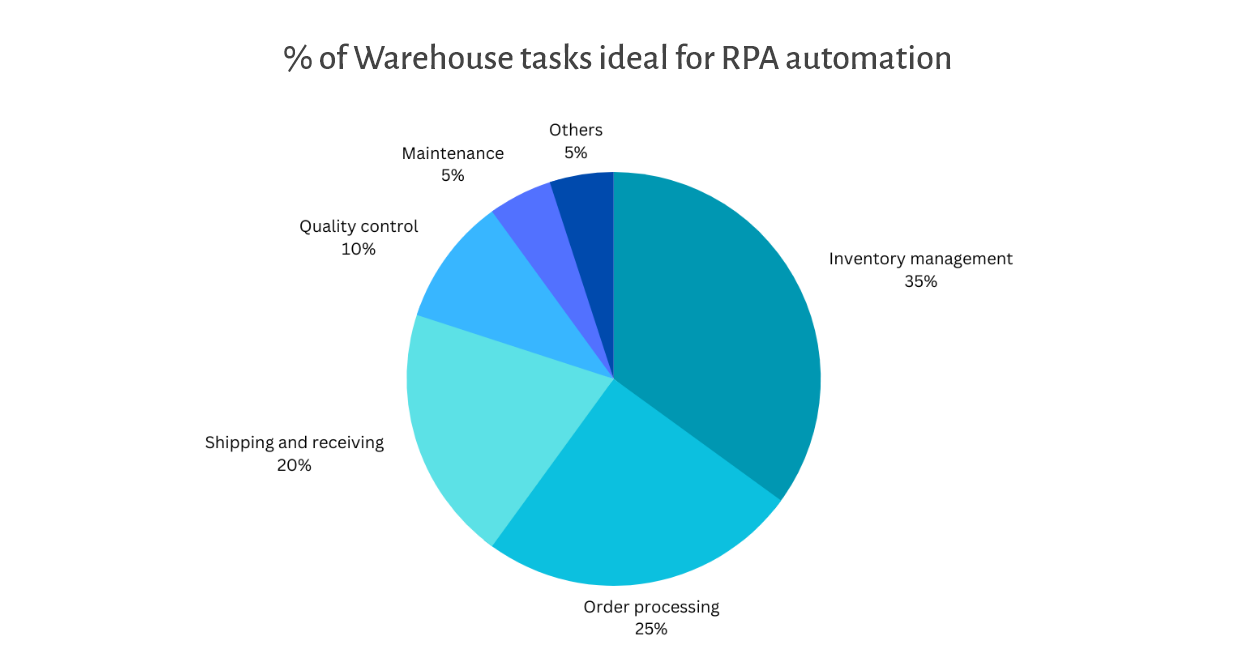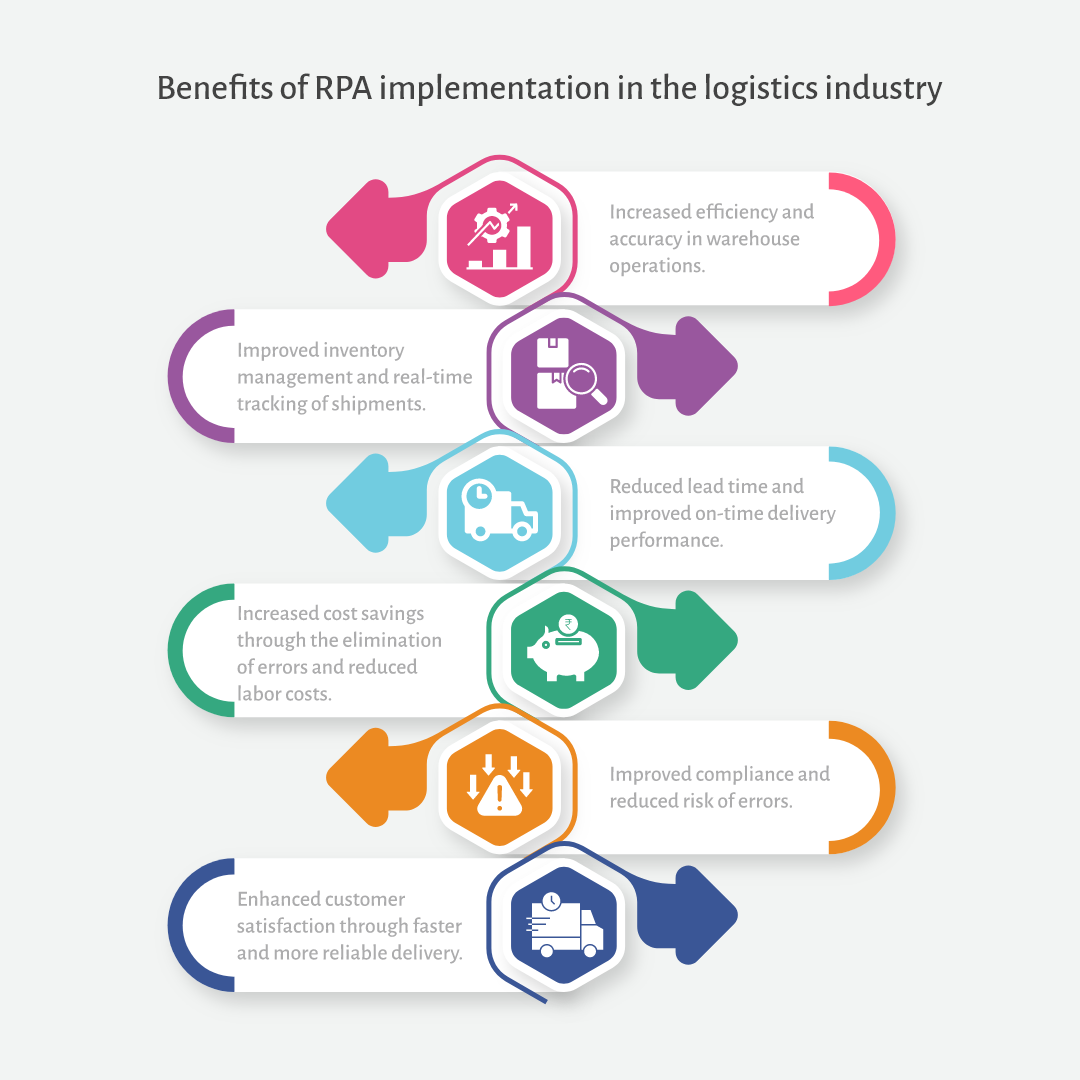Talosnation
As logistics professionals, we know that the industry can be complex and time-consuming. There are so many moving parts involved in getting products from point A to point B, and any delay or hiccup in the process can result in unhappy customers and lost profits. That's where RPA comes in.
RPA, or robotic process automation, has the power to transform the logistics industry as we know it. By automating repetitive and time-consuming tasks, RPA frees up valuable time and resources that can be better used elsewhere in the supply chain. From supply chain management to warehouse operations to last-mile delivery, RPA has the potential to make logistics more efficient, cost-effective, and customer-centric than ever before.
In this article, we'll explore the different ways RPA is revolutionizing logistics. We'll dive into real-life examples of RPA implementation and the benefits it brings to logistics companies. So, whether you're a logistics professional looking to streamline your operations or just curious about the impact of technology on the industry, read on for a comprehensive overview of the exciting world of RPA and logistics!
Streamlining Supply Chain Management with RPA

In the logistics industry, supply chain management is critical to success. It involves coordinating the movement of goods and materials from suppliers to manufacturers to distributors to retailers and, ultimately, to customers. Supply chain management is complex and time-consuming, but it's also essential for ensuring that products are delivered on time and at the right cost.
That's where RPA comes in. By automating various supply chain management tasks, RPA can streamline the process, reduce errors, and improve efficiency. Here are some examples of how RPA can be implemented in supply chain management:
- Inventory Management: RPA can automate the process of updating inventory levels and generating replenishment orders when stock levels fall below a certain threshold. This saves time and reduces the risk of human error.
- Order Processing: RPA can automate the process of processing orders, from verifying customer information to updating inventory levels to generating shipping labels. This reduces the need for manual input and speeds up the order fulfillment process.
- Shipment Tracking: RPA can automate the process of tracking shipments and updating customers on their order status. This provides real-time visibility into the supply chain and helps logistics companies identify and address any issues that may arise.
- Supplier Management: RPA can automate the process of managing supplier relationships, from negotiating contracts to processing invoices to monitoring supplier performance. This saves time and improves accuracy in supplier management.
But how do these RPA implementations compare to traditional supply chain management methods? Let's take a look:
- Inventory Management: With traditional methods, inventory management is often a manual process that requires a lot of time and effort. RPA can automate this process, reducing the risk of human error and improving efficiency.
- Order Processing: Traditional order processing methods often involve a lot of manual input and paperwork. With RPA, the process is streamlined, and orders can be fulfilled faster and with fewer errors.
- Shipment Tracking: Without RPA, shipment tracking can be a time-consuming and frustrating process for both logistics companies and customers. With RPA, real-time updates are provided, which improves transparency and communication.
- Supplier Management: Traditional supplier management methods can be tedious and prone to errors. With RPA, these processes are automated, which saves time and reduces the risk of mistakes.
Overall, RPA has the potential to revolutionize supply chain management in the logistics industry. By automating time-consuming tasks and reducing the risk of human error, logistics companies can improve efficiency, reduce costs, and deliver better customer service. So, if you're a logistics professional looking to streamline your operations and stay ahead of the competition, consider implementing RPA in your supply chain management processes.
Now that we've explored how RPA can streamline supply chain management, let's dive into how it can optimize warehouse operations and boost efficiency.
Optimizing Warehouse Operations

As any logistics professional knows, warehouses play a vital role in the supply chain. From receiving and storing inventory to picking and packing orders for shipment, there are countless tasks that need to be performed efficiently and accurately. That's where RPA comes in – by automating many of these tasks, warehouse operations can be optimized for maximum efficiency and productivity.
One of the most significant benefits of RPA in warehouse operations is the ability to automate inventory management. With RPA, robots can track inventory levels in real-time, making it easier to monitor stock levels and ensure that popular items are always in stock. This can also help reduce the risk of overstocking, which can tie up valuable resources and increase costs.
Another area where RPA can make a big difference is in order fulfillment. By automating picking and packing tasks, robots can speed up the process and reduce errors. This can lead to faster order processing times and increased customer satisfaction.
But what does RPA implementation in warehouse operations look like in practice? Let's take a look at an example.
Suppose a large e-commerce company is struggling with order fulfillment times due to the high volume of orders it receives. By implementing RPA in their warehouse operations, the company can automate many of the manual tasks involved in picking and packing orders, such as identifying the right product, selecting the correct quantity, and packing the items for shipment. This can significantly reduce order processing times and improve accuracy.
To demonstrate the impact of RPA on warehouse operations, we can compare a before-and-after scenario. Before RPA implementation, the e-commerce company might have relied on manual labor to fulfill orders, which could take several minutes per order. With RPA, however, the process can be completed in a matter of seconds, with robots quickly identifying and retrieving the correct items and packing them for shipment.
In addition to improving efficiency and accuracy, RPA can also reduce costs in warehouse operations. By automating tasks that would otherwise require human labor, companies can reduce their labor costs and reallocate resources to other areas of the business. In fact, some estimates suggest that RPA can reduce labor costs in warehouse operations by up to 50%.
Overall, RPA has the potential to revolutionize warehouse operations in the logistics industry. By automating tasks such as inventory management and order fulfillment, companies can improve efficiency, accuracy, and customer satisfaction while reducing costs.
As we bid adieu to the warehouse and move towards the final leg of the logistics journey, it's time to explore how RPA can optimize the crucial step of last-mile delivery. Let's dive into Enhancing Last-mile Delivery section.
Enhancing Last-mile Delivery

In the world of logistics, the final leg of the journey is often the most challenging. Last-mile delivery, which refers to the transportation of goods from the warehouse or distribution center to the customer's doorstep, is a critical step in the supply chain that can make or break the customer experience. With the rise of e-commerce and same-day delivery expectations, the pressure is on for logistics companies to optimize their last-mile operations.
This is where RPA comes in. Robotic process automation can enhance last-mile delivery by automating tasks such as route optimization and package tracking, enabling logistics companies to deliver goods more quickly and efficiently.
One of the most significant challenges of last-mile delivery is optimizing the delivery route to ensure that packages are delivered to customers in the most efficient and timely manner. RPA can analyze data such as traffic patterns, weather conditions, and delivery volume to optimize delivery routes and minimize delivery time. By automating this process, logistics companies can increase the number of deliveries per driver and reduce fuel costs, resulting in significant cost savings.
In addition to optimizing delivery routes, RPA can also improve package tracking and communication with customers. By automating the tracking process, logistics companies can provide customers with real-time updates on the status of their delivery, reducing anxiety and increasing satisfaction. RPA can also facilitate communication between drivers and customers by automating SMS and email notifications.
Several logistics companies have already begun to implement RPA in their last-mile delivery operations. For example, UPS has implemented an RPA system that optimizes its delivery routes and reduces fuel costs. Similarly, DHL has implemented RPA to track and monitor its delivery vehicles, resulting in increased efficiency and cost savings.
To better understand how RPA can enhance last-mile delivery, let's take a look at a hypothetical scenario. Imagine a logistics company that delivers packages to customers in a large metropolitan area. Without RPA, its drivers would have to manually plan their delivery routes based on their knowledge of the city and current traffic patterns. This process would be time-consuming and prone to errors, resulting in longer delivery times and increased costs.
With RPA, the logistics company can automate the route planning process based on real-time data analysis, resulting in optimized delivery routes and faster delivery times. In addition, the company can use RPA to track the status of each delivery and provide real-time updates to customers, increasing satisfaction and reducing customer inquiries.
In summary, RPA can significantly enhance last-mile delivery by optimizing delivery routes, improving package tracking, and increasing communication with customers. As e-commerce continues to grow, logistics companies must find innovative ways to improve their last-mile operations, and RPA is an excellent tool to achieve this goal.
Alright, moving on to section V, where we'll explore how RPA can improve the customer experience in the logistics industry. Let's dive in!
Improving Customer Experience
Customer experience is paramount in any industry, and the logistics industry is no exception. With the rise of e-commerce, customers have come to expect faster delivery times and better communication from logistics companies. In fact, a survey conducted by Deloitte found that 79% of customers consider the quality of delivery to be a key factor in their overall shopping experience.
This is where RPA can step in and make a significant impact. By automating tasks such as order processing and package tracking, RPA can ensure faster delivery times and more accurate delivery updates for customers. This not only enhances the customer experience but also reduces the workload on logistics companies, freeing up resources to focus on more complex tasks.
Let's take a closer look at some examples of RPA implementation in customer experience:
Order processing: RPA can automate the process of order processing, from receiving the order to forwarding it to the warehouse for fulfillment. This ensures that orders are processed quickly and accurately, reducing the risk of errors and delays.
Package tracking: RPA can track packages from the warehouse to the customer's doorstep, providing real-time updates to customers on the status of their delivery. This not only enhances the customer experience but also reduces the workload on customer service teams who would otherwise have to handle customer inquiries about the status of their package.
Communication: RPA can automate communication with customers, sending notifications and updates on their delivery status via SMS or email. This not only keeps customers informed but also reduces the workload on customer service teams who would otherwise have to handle these communications manually.
In addition to these examples, studies have shown that faster delivery times lead to higher customer satisfaction ratings. According to a report by Econsultancy, customers who receive same-day delivery are more likely to rate their experience positively than those who receive standard delivery.
All in all, RPA can significantly improve the customer experience in the logistics industry by providing faster delivery times, better communication, and more accurate delivery updates. This not only enhances the customer experience but also reduces the workload on logistics companies and customer service teams, freeing up resources to focus on more complex tasks.
Now that we've explored the benefits of RPA in improving the customer experience, let's move on to the final section where we'll discuss how RPA can address labor shortages and reduce costs.
Addressing Labor Shortages and Reducing Costs
The logistics industry is facing a growing labor shortage, which is putting pressure on companies to find innovative solutions to address the issue. Robotic Process Automation (RPA) is emerging as a key solution that can help logistics companies reduce labor costs and increase efficiency.
By automating repetitive tasks, such as order processing and inventory management, RPA can reduce the need for manual labor, freeing up employees to focus on higher-value tasks. This can help logistics companies address the labor shortage by reducing the number of workers required to operate their warehouses and other facilities.
In addition to reducing labor costs, RPA can also improve operational efficiency by automating processes that are prone to errors or delays. For example, RPA can help companies improve inventory accuracy by automating data entry and reconciliation, reducing the risk of stockouts and overstocking.
Several logistics companies have already begun to implement RPA to address labor shortages and reduce costs. For example, DHL has used RPA to automate order processing and customer service tasks, allowing them to reduce the number of employees required to handle these tasks. Similarly, FedEx has used RPA to automate customs clearance processes, reducing the time and cost required to clear shipments through customs.
As more logistics companies adopt RPA, we can expect to see a significant shift in the industry's labor dynamics. According to a recent report by McKinsey & Company, up to 45% of the tasks performed by workers in the logistics industry could be automated with existing technologies, resulting in significant cost savings and increased efficiency.
While some workers may be displaced by RPA adoption, the overall benefits to the industry and society as a whole are clear. By reducing labor costs and improving efficiency, RPA can help logistics companies offer better service at lower prices, benefiting both businesses and consumers.

Furthermore, the adoption of RPA can also lead to the creation of new jobs in areas such as data analysis and process optimization, providing opportunities for workers to develop new skills and pursue new career paths.
Ultimately, RPA is a key solution for addressing the labor shortage and reducing costs in the logistics industry. While there may be some challenges associated with its adoption, the benefits it can bring to the industry and society as a whole are significant. As more logistics companies adopt RPA, we can expect to see a more efficient, cost-effective, and innovative logistics industry emerge.
After exploring the benefits of RPA implementation in the logistics industry, it's clear that this technology has the potential to revolutionize the way we manage supply chain operations, optimize warehouse processes, enhance last-mile delivery, improve customer experience, and reduce labor costs.
Logistics companies that embrace RPA will be able to streamline their operations, reduce errors, increase efficiency, and deliver goods to their customers faster than ever before. With the current labor shortage in the logistics industry, RPA is a viable solution to automate repetitive tasks and free up valuable human resources to focus on higher-level tasks.
To ensure successful implementation, logistics companies should assess their current processes and identify which tasks can be automated using RPA. They should also invest in employee training to ensure a smooth transition and maximize the benefits of RPA implementation.
In conclusion, RPA is a game-changer for the logistics industry, and companies that are slow to adopt this technology risk falling behind their competitors. By embracing RPA, logistics companies can reduce costs, improve efficiency, and enhance customer experience, leading to increased revenue and business growth.
If you're interested in learning more about how RPA can help your Logistics Industry, TalosNation is here to help. Our team of experts can guide you through the implementation process and help you leverage the full potential of RPA technology. Contact us today to learn more about the benefits of RPA for Logistics Industry.
